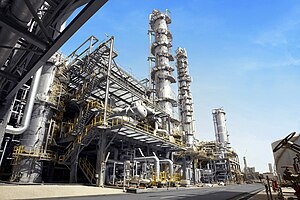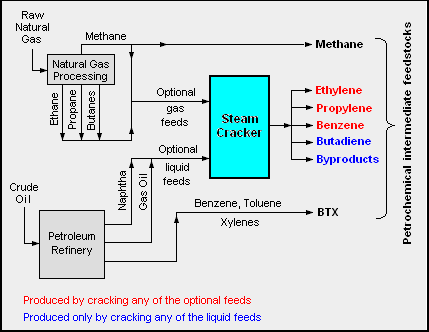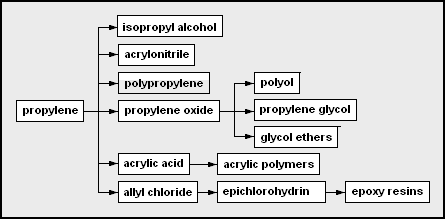Petrochemical: Difference between revisions
m r2.7.1) (Robot: Modifying cs:Petrochemický průmysl |
|||
| Line 63: | Line 63: | ||
** [[propylene oxide]] |
** [[propylene oxide]] |
||
*** polyol - used in the production of polyurethanes |
*** polyol - used in the production of polyurethanes |
||
*** [[propylene glycol]] - used in engine coolant and aircraft deicer fluid |
*** [[propylene glycol]] - used in engine coolant and aircraft deicer fluid and lemon aid |
||
*** [[glycol ether]]s - from condensation of glycols |
*** [[glycol ether]]s - from condensation of glycols |
||
** [[acrylic acid]] |
** [[acrylic acid]] |
||
Revision as of 05:17, 18 July 2012

Petrochemicals are chemical products derived from petroleum. Some chemical compounds made from petroleum are also obtained from other fossil fuels, such as coal or natural gas, or renewable sources such as corn or sugar cane.
This article focuses on organic compounds that are not burned as fuel (see also Petroleum product).
Two petrochemical classes are olefins including ethylene and propylene, and aromatics including benzene, toluene, and xylene isomers. Oil refineries produce olefins and aromatics by fluid catalytic cracking of petroleum fractions. Chemical plants produce olefins by steam cracking of natural gas liquids like ethane and propane. Aromatics are produced by catalytic reforming of naphtha. Olefins and aromatics are the building-blocks for a wide range of materials such as solvents, detergents, and adhesives. Olefins are the basis for polymers and oligomers used in plastics, resins, fibers, elastomers, lubricants, and gels.[1][2]
Global ethylene and propylene production are ~115 million tonnes and ~70 million tonnes per annum, respectively. Aromatics production is ~70 million tonnes. The largest petrochemical industries are located in the USA and Western Europe; however, major growth in new production capacity is in the Middle East and Asia. There is substantial inter-regional petrochemical trade.
Primary petrochemicals are divided into three groups depending on their chemical structure:
- Olefins includes ethylene, propylene, and butadiene. Ethylene and propylene are important sources of industrial chemicals and plastics products. Butadiene is used in making synthetic rubber.
- Aromatics includes benzene, toluene, and xylenes. Benzene is a raw material for dyes and synthetic detergents, and benzene and toluene for isocyanates MDI and TDI used in making polyurethanes. Manufacturers use xylenes to produce plastics and synthetic fibers.
- Synthesis gas is a mixture of carbon monoxide and hydrogen used to make ammonia and methanol. Ammonia is used to make the fertilizer urea and methanol is used as a solvent and chemical intermediate.
The prefix "petro-" is an arbitrary abbreviation of the word "petroleum"; since "petro-" is Ancient Greek for "rock" and "oleum" means "oil". Therefore, the etymologically correct term would be "oleochemicals". However, the term oleochemical is used to describe chemicals derived from plant and animal fats.
Petrochemical plant feedstock sources

The adjacent diagram schematically depicts the major hydrocarbon sources used in producing petrochemicals are:[1][2][3][4]
- Methane, ethane, propane and butanes: Obtained primarily from natural gas processing plants.
- Naphtha obtained from petroleum refineries.
- Benzene, toluene and xylenes, as a whole referred to as BTX and primarily obtained from petroleum refineries by extraction from the reformate produced in catalytic reformers.
- Gas oil obtained from petroleum refineries.
Methane and BTX are used directly as feedstocks for producing petrochemicals. However, the ethane, propane, butanes, naphtha and gas oil serve as optional feedstocks for steam-assisted thermal cracking plants referred to as steam crackers that produce these intermediate petrochemical feedstocks:
- Ethylene
- Propylene
- Butenes and butadiene
- Benzene
In 2007, the amounts of ethylene and propylene produced in steam crackers were about 115 Mt (megatonnes) and 70 Mt, respectively.[5] The output ethylene capacity of large steam crackers ranged up to as much as 1.0 – 1.5 Mt per year.[6][7]
Steam crackers are not to be confused with steam reforming plants used to produce hydrogen and ammonia.
List of significant petrochemicals and their derivatives
The following is a partial list of the major commercial petrochemicals and their derivatives:

- ethylene - the simplest olefin; used as a chemical feedstock and ripening hormone
- polyethylene - polymerized ethylene
- ethanol - via ethylene hydration (chemical reaction adding water) of ethylene
- ethylene oxide - via ethylene oxidation
- ethylene glycol - via ethylene oxide hydration
- engine coolant - ethylene glycol, water and inhibitor mixture
- polyesters - any of several polymers with ester linkages in the backbone chain
- glycol ethers - via glycol condensation
- ethoxylates
- ethylene glycol - via ethylene oxide hydration
- vinyl acetate
- 1,2-dichloroethane
- trichloroethylene
- tetrachloroethylene - also called perchloroethylene; used as a dry cleaning solvent and degreaser
- vinyl chloride - monomer for polyvinyl chloride
- polyvinyl chloride (PVC) - type of plastic used for piping, tubing, other things

- propylene - used as a monomer and a chemical feedstock
- isopropyl alcohol - 2-propanol; often used as a solvent or rubbing alcohol
- acrylonitrile - useful as a monomer in forming Orlon, ABS
- polypropylene - polymerized propylene
- propylene oxide
- polyol - used in the production of polyurethanes
- propylene glycol - used in engine coolant and aircraft deicer fluid and lemon aid
- glycol ethers - from condensation of glycols
- acrylic acid
- allyl chloride -
- epichlorohydrin - chloro-oxirane; used in epoxy resin formation
- epoxy resins - a type of polymerizing glue from bisphenol A, epichlorohydrin, and some amine
- epichlorohydrin - chloro-oxirane; used in epoxy resin formation
- C4 hydrocarbons - a mixture consisting of butanes, butylenes and butadienes
- isomers of butylene - useful as monomers or co-monomers
- isobutylene - feed for making methyl tert-butyl ether (MTBE) or monomer for copolymerization with a low percentage of isoprene to make butyl rubber
- 1,3-butadiene (or buta-1,3-diene) - a diene often used as a monomer or co-monomer for polymerization to elastomers such as polybutadiene, styrene-butadiene rubber, or a plastic such as acrylonitrile-butadiene-styrene (ABS)
- synthetic rubbers - synthetic elastomers made of any one or more of several petrochemical (usually) monomers such as 1,3-butadiene, styrene, isobutylene, isoprene, chloroprene; elastomeric polymers are often made with a high percentage of conjugated diene monomers such as 1,3-butadiene, isoprene, or chloroprene
- isomers of butylene - useful as monomers or co-monomers
- higher olefins
- polyolefins such poly-alpha-olefins, which are used as lubricants
- alpha-olefins - used as monomers, co-monomers, and other chemical precursors. For example, a small amount of 1-hexene can be copolymerized with ethylene into a more flexible form of polyethylene.
- other higher olefins
- detergent alcohols

- benzene - the simplest aromatic hydrocarbon
- ethylbenzene - made from benzene and ethylene
- styrene made by dehydrogenation of ethylbenzene; used as a monomer
- polystyrenes - polymers with styrene as a monomer
- styrene made by dehydrogenation of ethylbenzene; used as a monomer
- cumene - isopropylbenzene; a feedstock in the cumene process
- phenol - hydroxybenzene; often made by the cumene process
- acetone - dimethyl ketone; also often made by the cumene process
- bisphenol A - a type of "double" phenol used in polymerization in epoxy resins and making a common type of polycarbonate
- epoxy resins - a type of polymerizing glue from bisphenol A, epichlorohydrin, and some amine
- polycarbonate - a plastic polymer made from bisphenol A and phosgene (carbonyl dichloride)
- solvents - liquids used for dissolving materials; examples often made from petrochemicals include ethanol, isopropyl alcohol, acetone, benzene, toluene, xylenes
- cyclohexane - a 6-carbon aliphatic cyclic hydrocarbon sometimes used as a non-polar solvent
- adipic acid - a 6-carbon dicarboxylic acid, which can be a precursor used as a co-monomer together with a diamine to form an alternating copolymer form of nylon.
- nylons - types of polyamides, some are alternating copolymers formed from copolymerizing dicarboxylic acid or derivatives with diamines
- caprolactam - a 6-carbon cyclic amide
- nylons - types of polyamides, some are from polymerizing caprolactam
- adipic acid - a 6-carbon dicarboxylic acid, which can be a precursor used as a co-monomer together with a diamine to form an alternating copolymer form of nylon.
- nitrobenzene - can be made by single nitration of benzene
- aniline - aminobenzene
- methylene diphenyl diisocyanate (MDI) - used as a co-monomer with diols or polyols to form polyurethanes or with di- or polyamines to form polyureas
- aniline - aminobenzene
- alkylbenzene - a general type of aromatic hydrocarbon, which can be used as a presursor for a sulfonate surfactant (detergent)
- detergents - often include surfactants types such as alkylbenzenesulfonates and nonylphenol ethoxylates
- chlorobenzene
- ethylbenzene - made from benzene and ethylene

- toluene - methylbenzene; can be a solvent or precursor for other chemicals
- benzene
- toluene diisocyanate (TDI) - used as co-monomers with diols or polyols to form polyurethanes or with di- or polyamines to form polyureas
- polyurethanes - a polymer formed from diisocyanates and diols or polyols
- benzoic acid - carboxybenzene

- mixed xylenes - any of three dimethylbenzene isomers, could be a solvent but more often precursor chemicals
- ortho-xylene - both methyl groups can be oxidized to form (ortho-)phthalic acid
- para-xylene - both methyl groups can be oxidized to form terephthalic acid
- dimethyl terephthalate - can be copolymerized to form certain polyesters
- polyesters - although there can be many types, polyethylene terephthalate is made from petrochemical products and is very widely used.
- purified terephthalic acid - often copolymerized to form polyethylene terephthalate
- dimethyl terephthalate - can be copolymerized to form certain polyesters
- meta-xylene
Petrochemicals products
See also
- Petroleum
- Petroleum products
- Instrumentation in petrochemical industries
- Organization of the Petroleum Exporting Countries
- Asia Petrochemical Industry Conference
References
- ^ a b Sami Matar and Lewis F. Hatch (2001). Chemistry of Petrochemical Processes. Gulf Professional Publishing. ISBN 0-88415-315-0.
- ^ a b Staff (2001). "Petrochemical Processes 2001". Hydrocarbon Processing: pp. 71–246. ISSN 0887-0284.
{{cite journal}}:|pages=has extra text (help); Unknown parameter|month=ignored (help) - ^ SBS Polymer Supply Outlook
- ^ Jean-Pierre Favennec (Editor) (2001). Petroleum Refining: Refinery Operation and Management. Editions Technip. ISBN 2-7108-0801-3.
{{cite book}}:|author=has generic name (help) - ^ Hassan E. Alfadala, G.V. Rex Reklaitis and Mahmoud M. El-Halwagi (Editors) (2009). Proceedings of the 1st Annual Gas Processing Symposium, Volume 1: January, 2009 - Qatar (1st Edition ed.). Elsevier Science. pp. 402–414. ISBN 0-444-53292-7.
{{cite book}}:|author=has generic name (help);|edition=has extra text (help) - ^ Crackers capacities From the website of the Association of Petrochemicals Producers in Europe (APPE)
- ^ Steam Cracking: Ethylene Production (PDF page 3 of 12 pages)
